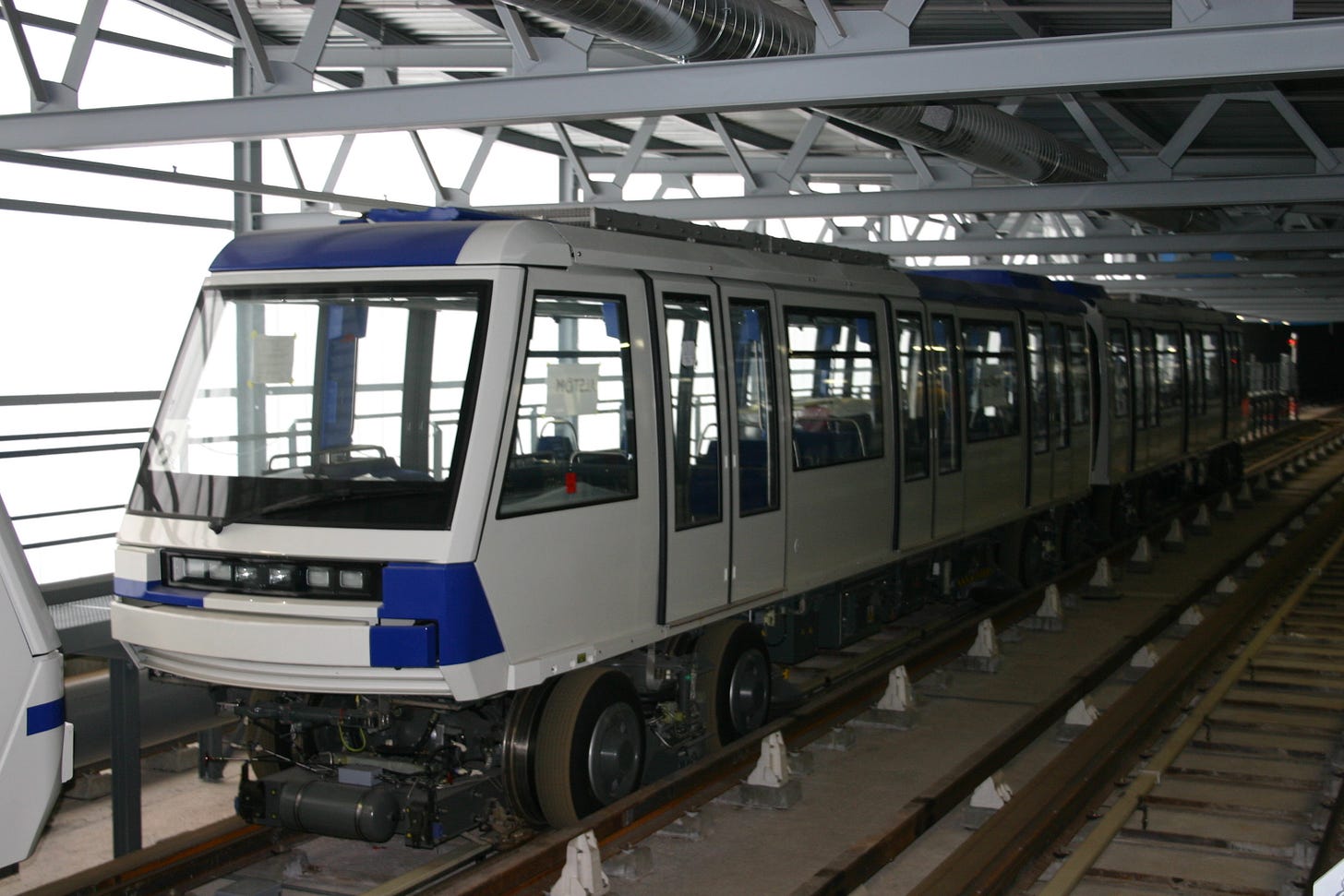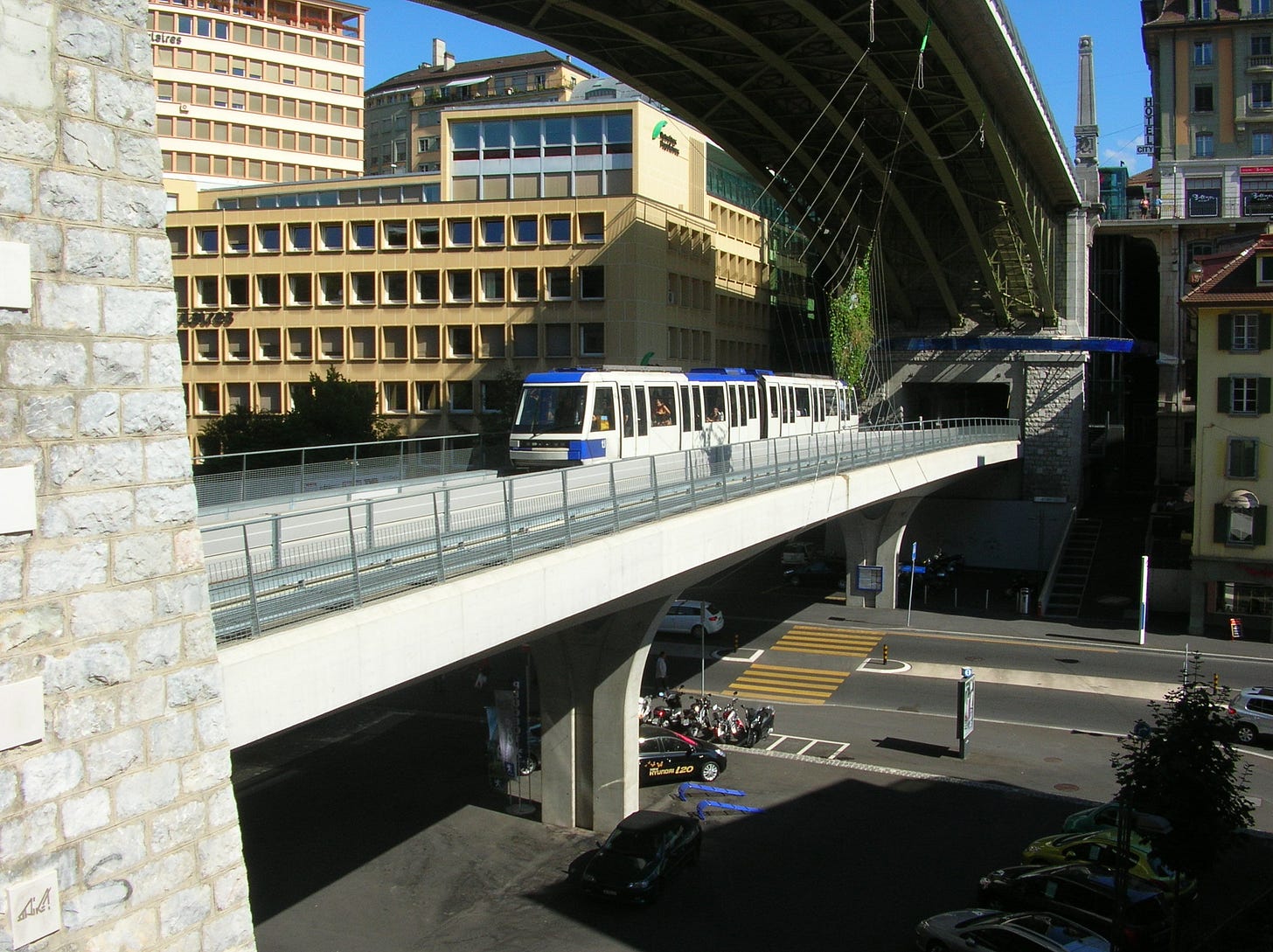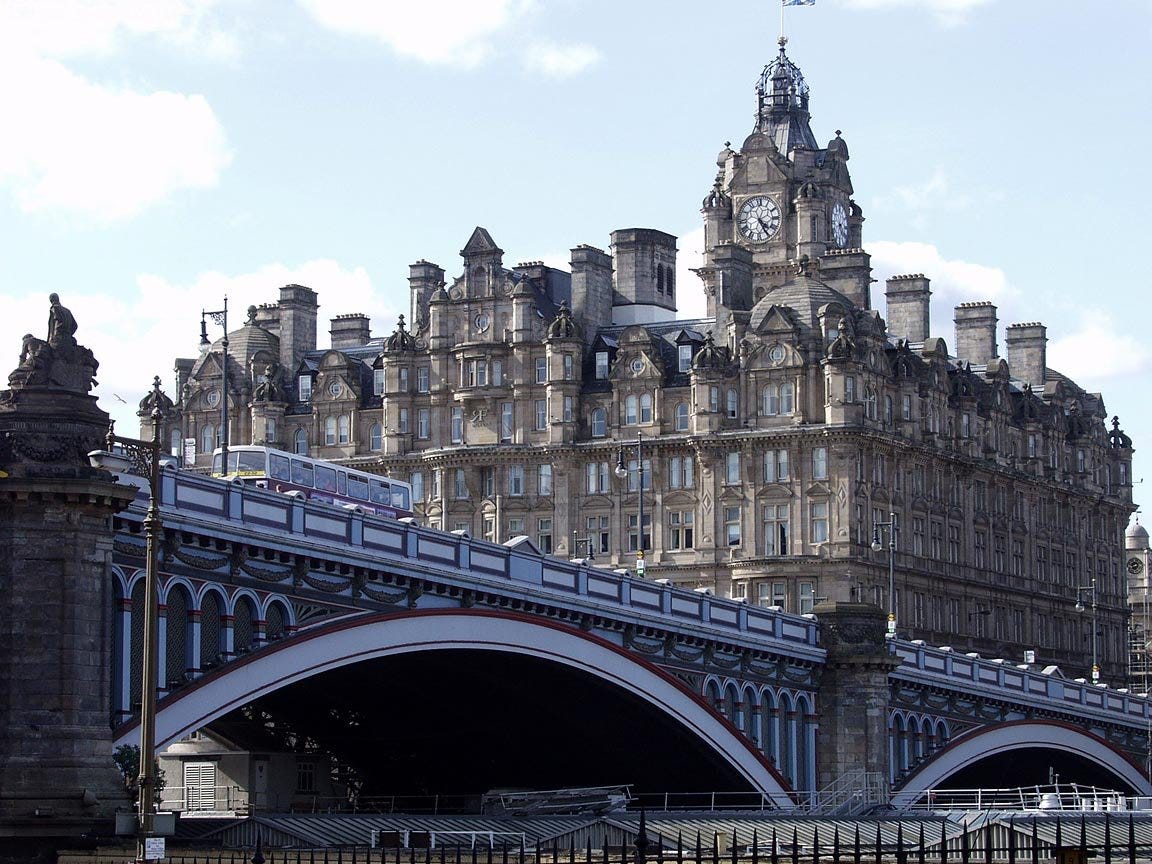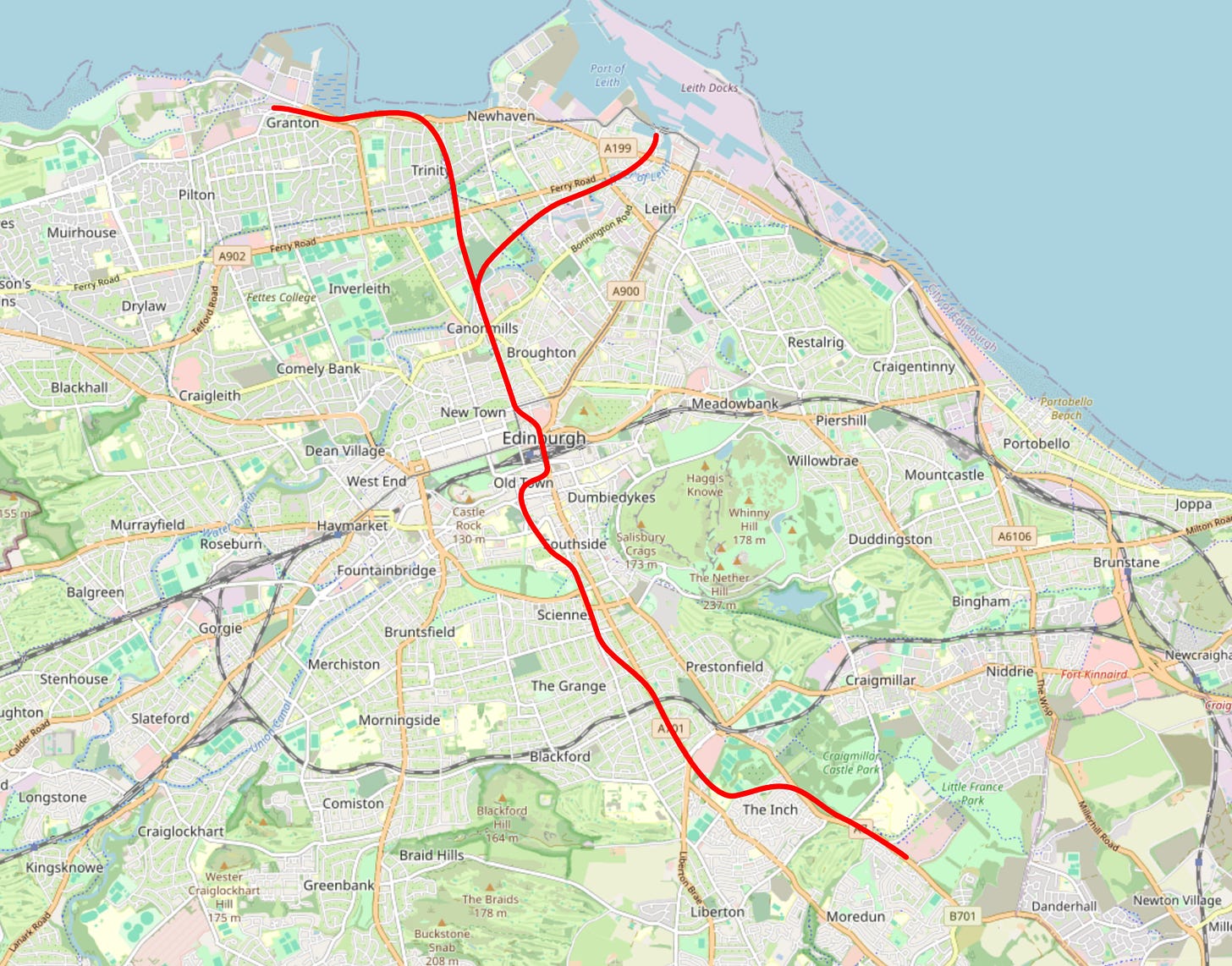Lausanne, in French-speaking Switzerland, is not a big city: it has 330,000 people within ten kilometres of its city centre. It is roughly the size of Derby.
And yet, it has two metro lines. This is unique among Swiss cities. Geneva is twice the size of Lausanne, and does not have a metro; Zürich is 2.5 times the size, and also does not have a metro – both cities are dependent on a tram network.
The nature of railways is that they can transport very large numbers of people quickly and reliably. The downside is that they have extremely large initial fixed costs, which is especially true if they are built in tunnels. As a result, metro systems are usually only viable in big cities, where there are enough passengers to make the big initial investment worthwhile.
Internationally, it is therefore rare to find a full metro system in a city with under a million people in its urban area. There are some smaller cities within Europe with metros, but even then, Lausanne (and a few other cities) is a clear outlier for the size of its network relative to its population.
How was Lausanne able to justify a metro? And might small British cities be able to copy her?
Lausanne’s geography
The Lausanne Métro has two lines. The more interesting of them is Line M2, which goes from Lake Geneva to the old city via the main station, and then continues to the northeastern suburbs. It is a proper metro line: it is fully separated from all other forms of traffic, and looks and feels like a metro.

A metro line made sense because Lausanne is an extremely hilly city. Lake Geneva is 372 m above sea level, while the old city, 2 km up the hill, is 495 m above sea level. Trams can just about cope with grades of 10% (compared to about 2.65% for the steepest gradient on a mainline railway in Britain, the Lickey Incline), but this comes at a speed penalty. Thanks to the hills, Lausanne’s street layout is not conducive to trams: the roads are wiggly as well as steep.
M2 is an extension of a Victorian-era railway line that connects the station with the lakefront. The line, which has grades of 12%, was initially operated as a funicular, and later as a rack railway, and rather unsatisfactorily terminated at the main station, which is 500 m away (and down a hill) from the city centre.
To get around the problem of steep grades, M2 was built as a rubber-tyred metro. Rubber-tyred systems originated in Paris, and have since spread to other French-speaking cities like Montréal, although they are rare outside of la Francophonie. Rubber-tyred metros have the advantage that they can traverse much steeper grades than steel-wheeled systems.

Nothing can really prepare you for how steep the Lausanne Metro is:

The other line, M1, is less interesting. It connects Lausanne’s two universities, which share a suburban campus to the west of the city centre, with the centre and with the shoulder station of Renens. It looks and feels more like a tram than M2, and the stations don’t make you feel like your head is spinning.
Light metro methodology
Lausanne therefore has two corridors where a metro line can generate enough traffic to be viable. Even so, it is a small city: neither corridor could be expected to generate as much traffic as a similar connection in a bigger city. Both lines are light metro lines.
‘Metro’ is a term that is often unhelpfully imprecise. It is often defined as requiring full grade-separation from other forms of traffic. By that definition, Lausanne M2 is a metro line, while M1 is a ‘light rail’ line. But I don’t think this is especially helpful. Transit (like transit enthusiasts) is on a spectrum, ranging from a tram that shares tracks with cars at one end, to very high capacity, grade-separated systems like the London Underground at the other. Trying to draw an arbitrary terminological line helps nobody.
‘Light metro’ is not a technology per se, but rather a way of building transit that tries to get as many of the benefits of a full-fat metro as possible, while aggressively reducing costs.
M2 uses small, automated, driverless trains. They are miniscule: two carriages and 30 metres long. But Lausanne manages to squeeze a fair amount of capacity out of them. The short distances mean that there is no need for very many seats, so each train can transport up to 315 passengers if they are crammed in like sardines.
At the moment there are up to 20 tph, giving a capacity of 6,300 passengers per hour per direction (pphpd), but because the system is driverless there is room to expand the frequency in the future: Line 14 of the Paris Métro, which uses the same basic technology as M2 in Lausanne, apparently has a train every 85 seconds. If these frequencies were ever needed in Lausanne, M2 would be able to move 13,230 pphpd.
This is obviously much lower than the capacity of many other metro lines: Line 14, which uses 8-carriage trains, can move 39,144 pphpd, and the Victoria Line narrowly pips it to the post with 40,608 pphpd – but clearly Lausanne does not need the capacity of a megacity like Paris or London.
What makes M2 noteworthy is that it gets capacity by running a frequent service, rather than by running longer trains. Frequency is a good thing in itself, but more importantly, longer trains require longer platforms – in other words, higher construction costs. M2 cost CHF 740 million, or £733 million in today’s pounds – £124 million per kilometre.
As for the stations, most of them are clearly built cut-and-cover. The entrances are small, typically only an elevator to each platform and some stairs. They are not spartan, but they are certainly built in a way that minimises costs: Bessières, which is built underneath one of Lausanne’s main bridges, just has two elevators, one to each platform.

M1 takes a different approach to reducing costs. Except for a few short sections, it runs above-ground. As mentioned, it has several level crossings with vehicle traffic, and at some stations passengers get from the entrance to one of the platforms by crossing over the tracks. But the lack of grade separation enables lower costs: the track crossings, for instance, mean that some stations need only one lift rather than two.
Cost-reduction can be taken too far. M1 is, inexplicably, single-track: although trains can pass one another at most of the stations, this restricts the frequency to 8 tph. While the Swiss are extremely good at squeezing capacity out of single-track sections of line on their mainline railway network, this is not something they should be doing: single-track lines should be limited to rural branch lines, not metros or major arteries. The capacity is correspondingly lower: although M1 can run longer trains, it can move only 4,912 pphpd.
Both lines are astoundingly successful. French Wikipedia quotes (without citing any other sources1) 2023 figures of 35 million passengers per year for M2, and 15 million per year for M1. By itself M2 carries nearly as many passengers as the entire Tyne and Wear Metro, even though Newcastle and Sunderland are both bigger than Lausanne, and even though the whole of the Tyne and Wear Metro system has 60 stations, compared with 14 for M2.
So, given that Lausanne and Derby are the same size, should Derby have a metro?
Lessons for Britain
The answer is ‘no’.
Lausanne only has a metro because of its unusual geography: if it had been a more normal city, then it would have a tram, like other Swiss cities. Trams are fine in smaller cities, provided they are not too hilly.
(One place I am interested in is Rennes, in northwestern France, which has a similar ratio of population to metro stations as Lausanne. It does not appear to have Lausanne’s specific geographical challenges, yet it too has a light metro – while bigger French cities, like Bordeaux, only have a tram.)
Where is the British equivalent of Lausanne? I think Edinburgh. It is bigger than Lausanne – 560,000 people within 10 km – and its economic performance and importance for tourism means that it probably generates more traffic than its population would suggest.
Edinburgh already has a tram network, which it should expand – there are several disused suburban railway lines that are ripe for the taking.
But there is an obvious corridor where trams would be difficult: connecting the New Town, Waverley Station, the Old Town, and the university. The streets in this area are too small and winding (and full of tourists) for trams to be anything more than a slow bus.
A light metro line (with slightly higher capacity than Lausanne M2) might be a sensible idea. It also would be quite fun to copy Lausanne, and have a station underneath the North Bridge over Waverley station, with views towards the Castle and Calton Hill.

This is a very rough proposal, so don’t take it too seriously – please leave a comment if there is something I have obviously not thought of. It involves re-using a disused tunnel and old trackbed most of the way between Leith and Granton and the New Town, and then tunnelling southwards. At 50% above Lausanne costs (to account for slightly longer trains) this would be £1.8 billion for an initial 10 km-long system between the Scottish Government offices in Leith and the BioQuarter next to the Edinburgh Royal Infimary.
More generally, light metro methodology is a useful way of reducing costs, even in slightly bigger cities. Bristol is another example: a tram-metro in Bristol would be difficult to build, due to the lack of wide streets in the suburbs, and a tram would be challenging due to the hilly, windy streets in the centre. Bristol is not big enough that a ‘heavy’ metro would be viable, but a light metro might just be.
Another example is London. Light metros have nowhere near enough capacity to serve the centre, but I think that they could be very useful for orbital transport. Fifteen years ago there was a proposal floating around for a light metro in north west and west London, connecting Ealing, West Hampstead, Wembley and Finchley.
Indeed, London has one of the best examples of a light metro in the world: the DLR. It was built on a shoestring, to the point of being underbuilt. But the fact that it was built so cheaply meant it did exist to give the Docklands good enough connections that Canary Wharf became possible. We should not necessarily expect that a light metro line in Edinburgh or Bristol will have the same transformative effect: but by an aggressive focus on cost reduction, it might be possible for those cities finally to have good, fast transit.
The figures probably are correct, as they tally with the 2019 figures from this source.



How did Lausanne build the tunnels? Cut and cover or TBM?
Rennes is quite compact and as they control their finances (VT) chose to go for a metro rather than tramway. Probably helps given how wet and wild it can get there in winter.
I happened to be in Rennes in 2006(?), when the Metro was being built. I was astounded that such a small conurbation had found the funding. I must go back and ride the system.